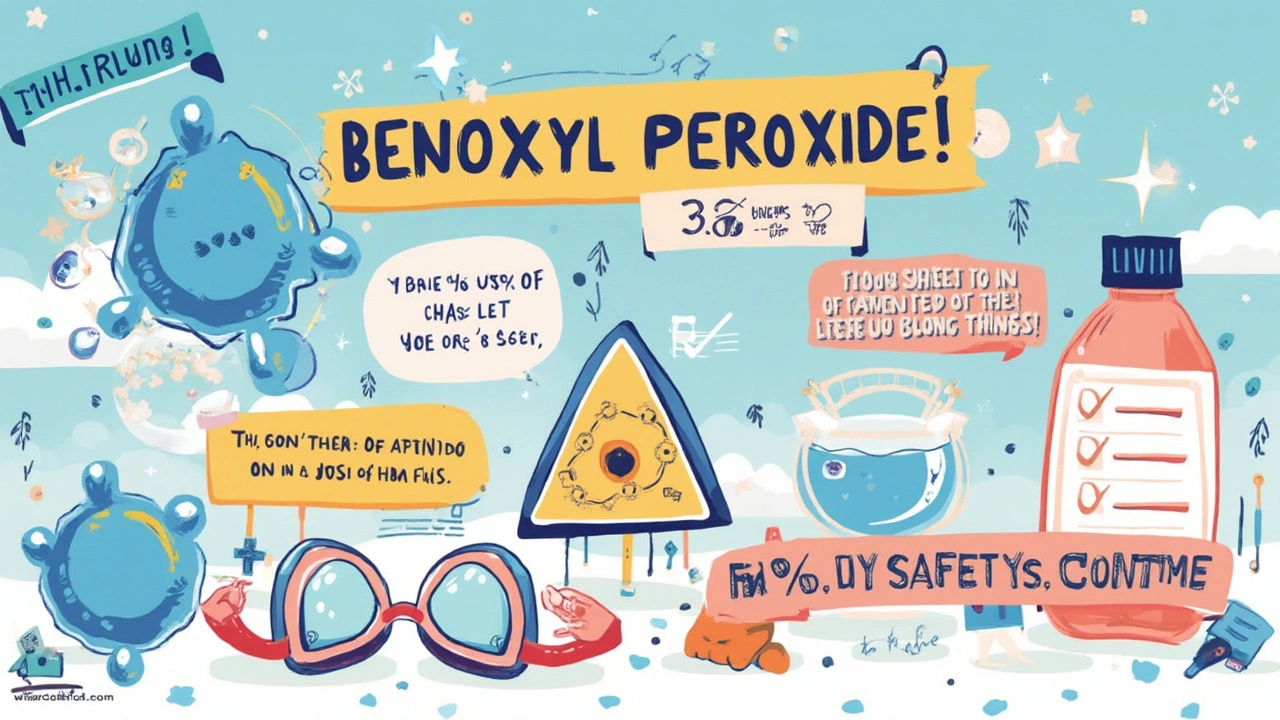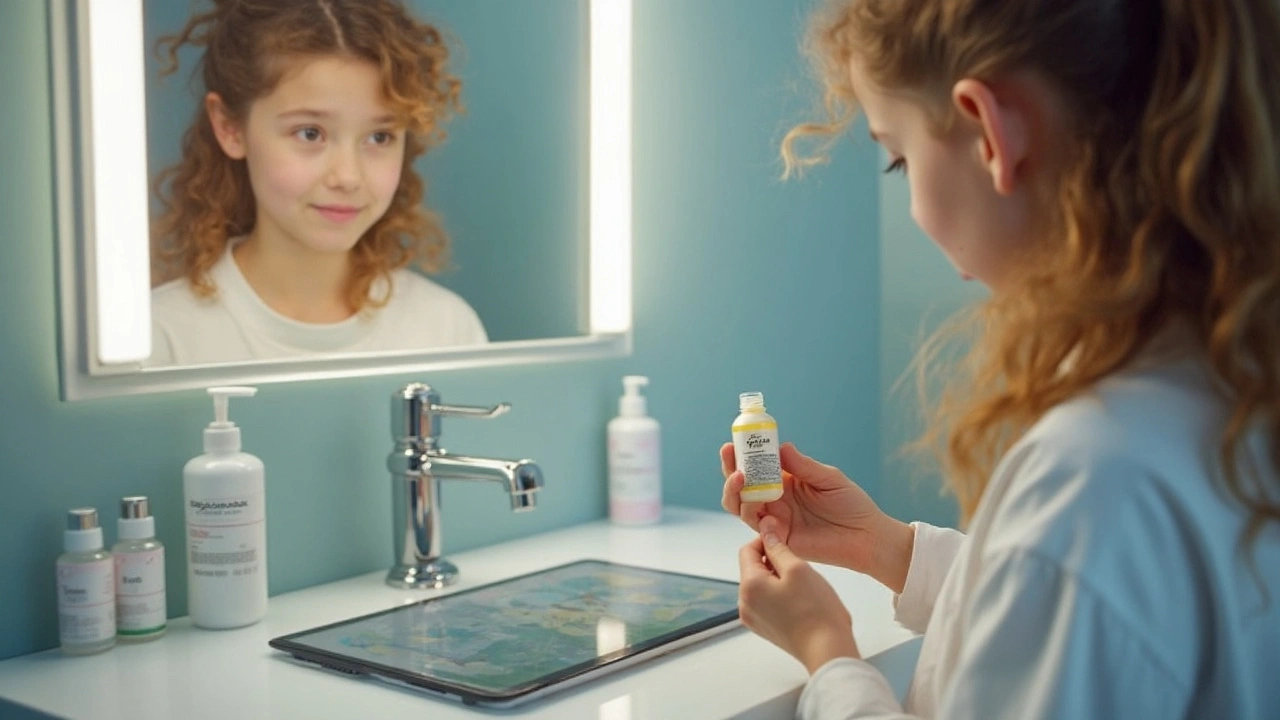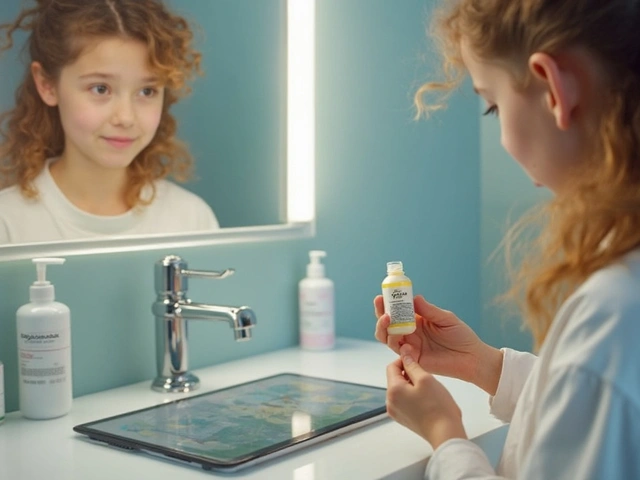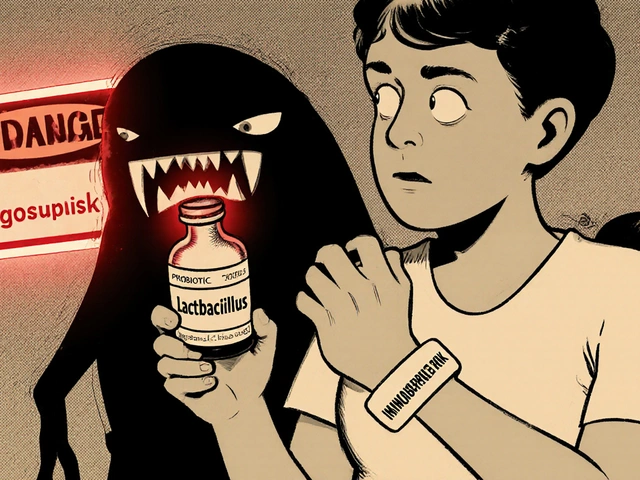If you’ve ever stared hopelessly into the mirror at those stubborn red zits, you know the burning question: what really works fast, without turning your skin into a peeling mess? Enter benzoyl peroxide. This isn’t some new influencer trend; this is a chemical that’s been waging war on acne since the 1960s. Most of us know it as the backbone of famous spot creams and face washes, but there’s a lot more to benzoyl peroxide than just swiping a dab onto a breakout. Trust me, the story behind this molecule runs deep—right from chemistry lab benches to bathroom cabinets, and even into things like teeth whitening and industrial bleaching. The secret sauce? How benzoyl peroxide harnesses oxygen’s raw power to fight off bacteria, dissolve dead skin, and unclog pores before you can say "exfoliate." And it does all that without a prescription. But that’s just scratching the surface. Want to know what makes it tick, how to really use it without frying your skin, plus what nobody tells you about side effects and safety? Stick with me.
The Science and Surprising Uses of Benzoyl Peroxide
Benzoyl peroxide belongs to the organic peroxide family, but don’t let the word “organic” fool you. At the molecular level, it’s a powerhouse. Its structure is basically two benzoyl groups linked by a peroxide bridge. When applied to your skin, this structure breaks down, releasing free oxygen radicals. That sounds technical, but here’s the cool part: those oxygen radicals set off a biochemical chain reaction that obliterates the acne-causing bacteria, Cutibacterium acnes, by literally suffocating them (they’re anaerobic—no friends with oxygen). It gets better. Benzoyl peroxide also causes your skin to shed dead cells more quickly, which helps unclog pores, another crucial part of fighting acne. One lab test showed benzoyl peroxide can cut acne-causing bacteria by over 90% in just 48 hours. That’s seriously fast compared to a lot of other treatments.
But the action doesn’t stop with acne creams. This compound is ridiculously versatile. Industrial manufacturers use benzoyl peroxide as a hardener for resins in things like fiberglass boats and surfboards. Dentists include it in some teeth-whitening gels (though in lower concentrations than in hardware stores, thankfully). Ever wondered how “clear” plastic signs are made so smoothly? Benzoyl peroxide helps kickstart polymerization reactions in acrylics. That just means it helps turn simple building blocks into sturdy, clear sheets. Food manufacturers have used it as a flour bleaching agent, although recent regulations have pulled back on that use in Europe due to some safety concerns. So, if you’ve ever thought benzoyl peroxide only hit the shelves of drugstores—surprise. Its reach goes way wider.
Let’s talk about concentrations. In the U.S., over-the-counter acne products usually pack 2.5% to 10% benzoyl peroxide. Prescription forms sometimes go higher but come with more risk of dryness or irritation. What’s wild is, more doesn’t always mean better. One large clinical study found that a 2.5% concentration worked just as well as higher percentages, but with way less irritation. So if you’re on the fence at the drugstore, sometimes starting low is the smarter play. It’s one of those times in life when being gentle is actually more effective.
Check this out: some benzoyl peroxide uses and details broken down in a handy table.
| Application | Concentration | Main Use | Notes |
|---|---|---|---|
| Skin creams (acne) | 2.5% - 10% | Reduces acne, unclogs pores | Start low to avoid irritation |
| Teeth whitening gels | 0.1% - 1% | Whiten teeth, bleaching | Professional use preferred |
| Plastic manufacturing | Varies (high %) | Polymerization of plastics | Not for skin contact |
| Flour treatment (now rare) | ~0.01% | Whiten flour | Mostly phased out in EU |
One thing you might not know: benzoyl peroxide can bleach fabrics faster than you can say “ruined pillowcase.” Even tiny amounts transferred from your face at night can leave ghostly orange or white blotches on towels and linen. Always double rinse your hands, and if you sleep with cream on, switch to light-colored bedding.
A fun little chemistry tidbit—benzoyl peroxide is one of the rare compounds that’s stable enough to bottle but explosive enough that it’s used in small amounts in safety matches and fireworks as a catalyst for ignition. Don’t worry, nothing on your skin is about to detonate, but it gives you an idea of how potent this molecule really is.

Benzoyl Peroxide in Skincare: Myths, Tips, and How to Avoid Disaster
Here’s where a lot of people trip up. The “more is better” philosophy doesn’t fly with benzoyl peroxide. Piling on thick layers or graduating to high-strength gels too fast is a surefire path to raw, peeling, itchy skin. For anyone out there thinking, “I’ll just blast these spots right off,” slow down. Dermatologists recommend starting with 2.5% creams or gels—sometimes even less if your skin is naturally sensitive. You need to build tolerance gradually. The trick is to use a pea-sized amount, spread it into a thin layer over the entire affected area, not just individual pimples. This helps prevent new breakouts, not just treat the ones you see.
Got dry or flaking skin after a week on benzoyl peroxide? That’s common. The fix is pretty straightforward: pair it with a lightweight, fragrance-free moisturizer. Layer the moisturizer first, then the benzoyl peroxide. You’ll still get the bacteria-busting effect, and your skin barrier won’t take a beating. If you’re mixing it up with other acne fighters—like retinoids or salicylic acid—space them out (morning and night, not both at once), otherwise irritation is almost guaranteed. This mix-and-match approach can be super effective if you do it thoughtfully.
People with darker skin sometimes worry about light spots or discoloration after using acne treatments. Benzoyl peroxide isn’t directly linked to hyperpigmentation, but heavy irritation can cause lingering redness or dark marks, especially if you pick at healing skin. Wearing sunscreen is non-negotiable, like brushing your teeth every morning. UV rays can make treated skin more sensitive and crank up your risk for post-inflammatory dark spots. Grab a non-comedogenic sunscreen rated SPF 30 or higher and you’ll thank yourself later.
You’ve probably heard that benzoyl peroxide can “purge” your skin, making it worse before it gets better. Partly true, partly overhyped. As your pores start clearing out, some old clogs surface—usually settling within two to four weeks. If breakouts explode suddenly or you see swelling, crusty rashes, or hives, stop using it. You might be dealing with an allergy (rare, but real), not a purge.
Creams and gels aren’t the only options. There are benzoyl peroxide cleansers, body washes, and even leave-on spot pads. If your breakouts appear on your back or chest, a foaming wash is a great way to treat bigger areas, just don’t leave it sitting too long, or you could dry out even healthy skin. Some shampoo brands include low amounts for folks fighting folliculitis (inflammation of hair follicles), which looks like acne but is actually a bit different. Check ingredient labels—sometimes benzoyl peroxide lurks where you least expect it.
Ever wondered why your dermatologist doesn’t immediately hand out benzoyl peroxide to everyone with acne? It’s about picking the right tool for the right person. Some folks see dramatic results in days; others barely notice a change. Genetics, hormone levels, and even habits like touching your face or eating high-glycemic foods (think white bread and sugar bombs) all come into play. For women, hormonal shifts around periods can make breakouts more stubborn. Benzoyl peroxide works best for mild to moderate, inflamed acne—not deep cysts. For those, prescription meds like oral antibiotics or retinoids usually work better in the long run.
If your skin stings, looks worse after several weeks, or starts peeling uncontrollably, dial back or take a break. Most irritations clear quickly once you stop. If you have eczema, rosacea, or super-reactive skin, ask a doctor before starting. Pregnant or breastfeeding? Current guidelines say small amounts on limited skin are likely safe, but it’s always smart to double-check.

Benzoyl Peroxide Beyond Acne: New Research, Safety Hacks, and Smart Tips
Benzoyl peroxide isn’t just stuck in the acne aisle. Scientists have been exploring its antibacterial powers far beyond zits and blackheads. There’s early evidence it helps with skin infections like folliculitis and may even play a role in reducing antibiotic resistance. Since bacteria can become resistant to antibiotics but not to oxygen, pairing low-dose antibiotics with benzoyl peroxide slows down superbug mutations. In fact, some dermatologists almost never prescribe topical antibiotics alone anymore—they pair them with benzoyl peroxide to outsmart bacterial resistance. That means clearer skin now, less risk of staph or MRSA down the line.
Animal studies and computer models are examining whether benzoyl peroxide’s oxidizing “punch” can hit other types of bacteria and fungi—opening the door for new antimicrobial products. Don’t expect benzoyl peroxide to show up in surgical hand soaps tomorrow, but the research direction is clear: the stuff is tough on germs and could become a staple in fighting more infections if used right. Naturally, the big concern is irritation—keep it away from delicate mucous membranes and never use it around your eyes.
If you’re using benzoyl peroxide and seeing “no results,” re-check your routine. Here are practical steps for best results:
- Wash your face with a mild cleanser (no harsh scrubs).
- Pat dry, don’t rub.
- Wait up to 10 minutes before applying benzoyl peroxide (lets skin settle and reduces stinging).
- Apply a thin, even layer, not just on individual marks.
- Use sunscreen every single day; treated skin burns more easily in the sun.
- Consider cycling off for a few days if skin flakes or tightens—moisturize and let your skin recover.
- Swap pillowcases and towels often to prevent product buildup and bacteria transfers.
One tip hardly anyone shares: store your benzoyl peroxide at room temperature or in a cool, dark place. Heat and sunlight can make it break down faster, so don’t leave tubes in a hot car or steamy shower corner. Most products have a shelf life of 6 to 12 months after opening. If the texture changes, smells weird, or turns watery, swap it for a fresh one.
Let’s not ignore the eco side. Benzoyl peroxide doesn’t build up in your system, and what washes off your skin breaks down into simple byproducts. But some researchers are looking at the long-term effects of oxidizers on city water systems, since everything rinsed off at home heads down the drain. So far, evidence shows it breaks down quickly—nothing like the microbeads that used to harm fish and rivers—but watch this space as eco groups push for more studies.
Ever read online that benzoyl peroxide can cause cancer? That myth keeps cropping up. Decades of safety testing—including big reviews by the FDA and European agencies—have found no link between normal topical use and cancer. The confusion started when super high doses were used in animal studies, doses nobody would ever apply to their face. Used as directed, it’s considered safe for most folks.
Before you start, remember: benzoyl peroxide isn’t a silver bullet for everyone, but for millions it’s a benzoyl peroxide blast that brings results. The right formula, a careful approach, and realistic expectations are what separates a skincare win from a regret. When you hit your routine right, benzoyl peroxide brings more balance, less redness, and glow that comes from clear, healthy skin. Want something stronger or lasting for stubborn spots? Go to a dermatologist—sometimes, it takes expert backup. But don’t write off this classic acne weapon. Turns out, science’s old favorites sometimes pack the best punch.







Write a comment
Your email address will be restricted to us